A look back at Rudolf Nureyev's Empire Theatre disaster 30 years on
and live on Freeview channel 276
Born aboard a Trans-Siberian Railway train in 1938, he became world famous for his incredible abilities and his sensational defection to the West in 1961.
He electrified audiences, particularly with his best known partner Margot Fonteyn. But his time in Sunderland was the beginning of the end; and not only because it was the start of his farewell tour.
Advertisement
Hide AdAdvertisement
Hide AdThe “gala evening”, rather than a specific ballet, was a massive coup for the Empire Theatre when, in January 1991, it was announced he would perform on April 26 and 27, with a third date on May 13.
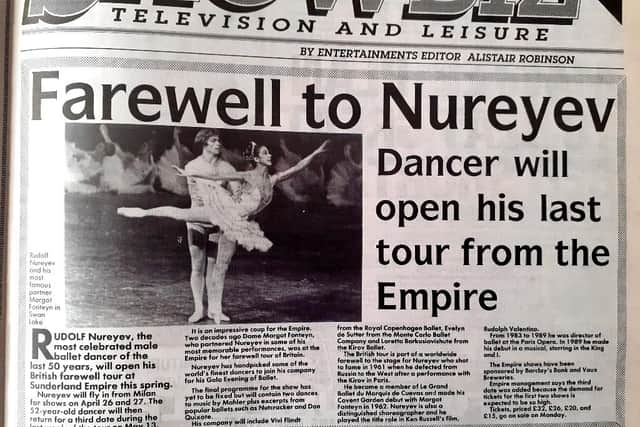

His April performances were sandwiched between those of Freddie Starr and Daniel O’Donnell. Nureyev’s Sunderland shows would be sponsored by Vaux Breweries.
The announcement caused considerable excitement and tickets were soon sold out, despite a top price of £32; equivalent to about £75 in 2021.
The first show in particular would prove disastrous.
Rudolf on Wearside
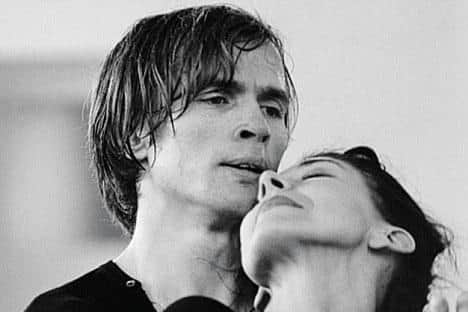

The Russian didn’t endear himself to the media. He avoided a press conference at Gatwick Airport by flying to Heathrow. He then flew to the North East, but warned the Empire he would cancel his performances if anyone tried to photograph him.
Advertisement
Hide AdAdvertisement
Hide AdThe Echo’s entertainments editor Alistair Robinson attempted to interview him at his hotel after the first-night fiasco, only to be informed by a PA that the great man was resting.
Alistair wrote: “I hope his reclusiveness was also inspired by shame at the way he treated his first-night fans.”
But Nureyev was seen in public. On the Saturday afternoon he had a drink in the Dun Cow next door to the theatre and chatted with regulars.
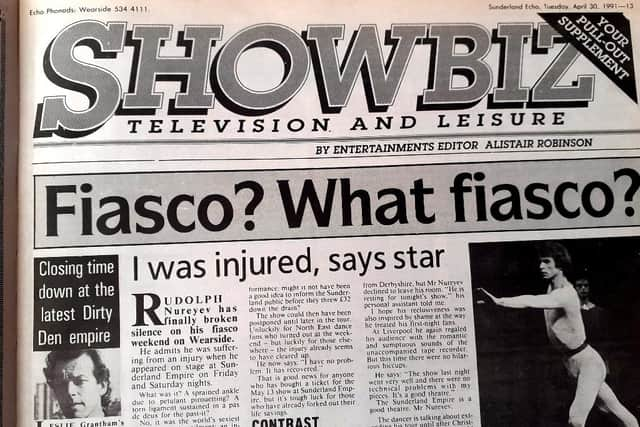

Peter Cain, a barman back then, said: “I thought at first he looked like Clint Eastwood. It turned out it was Rudolf Nureyev. I think he was wearing a cape and a beret.”
The performances – and the Chocolate Hobnobs
Advertisement
Hide AdAdvertisement
Hide AdOn Friday, April 26 Nureyev left the Moat House Hotel in Washington at 6.30pm and began his show at 7.50pm – 20 minutes late. There was no orchestra, only a tinny tape machine. The audience, tingling with anticipation for months, were not impressed.
Worst of all was that he simply danced terribly. He “seemed injured” according to the Echo. The show’s other dancers were also maligned.
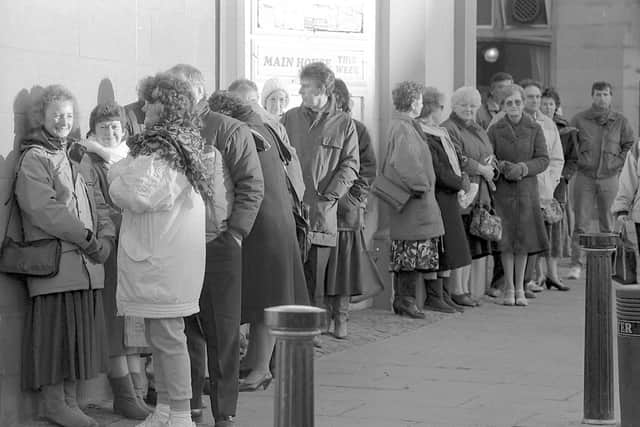

One woman in the audience said: “I have waited 25 years to see this man and I was absolutely shocked. He didn’t really dance. He shouldn’t have been paid. I’m surprised he wasn’t slow hand-clapped.”
But why was Nureyev so bad? It transpired that he was suffering from an ingrown toenail, which he eventually deigned to explain to the paying public.
Advertisement
Hide AdAdvertisement
Hide AdThis did not spare him the wrath of Alistair Robinson, who wrote: “If he insisted on going ahead with this ill-advised tour and had known the injury was going to affect his performance, might it not have been a good idea to inform the Sunderland public before they threw £32 down the drain?”
Letters to the Echo included comments such as: “I came away frustrated and close to tears. It was the worst display I have seen” and, “He has no right to exploit the public like he did in Sunderland.”
His performances at other British venues didn’t exactly draw rave reviews either. Others however, particularly at the second and third Empire shows when the quality of sound had been improved, enjoyed the experience and thought the criticism somewhat extreme.
Ballet aficionado Joanna Duncan, now an English teacher at St Anthony’s, has fond memories of both of those performances.
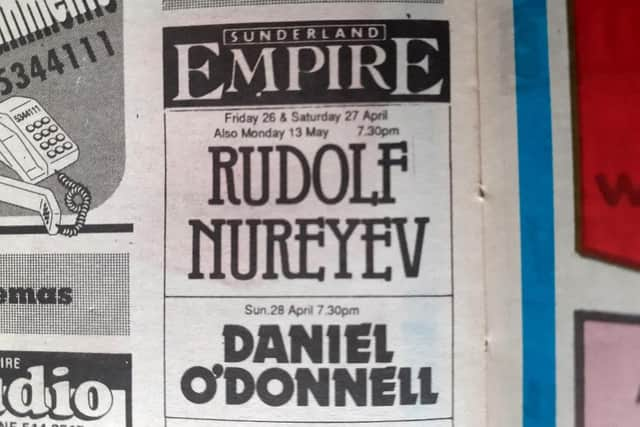

Advertisement
Hide AdAdvertisement
Hide AdShe said: “It was fabulous to have him at the Empire. But a lot of people still expected him to be in the prime of his dancing career. He did dramatic pieces, not the ‘firework’ stuff he’d done in the 60s. But he was fantastic.”
“My mam and I met him backstage and he was lovely. One woman had read that he liked Chocolate Hobnobs, so she gave him a packet and he was very gracious. It was like meeting royalty.”
Consequences and Sunderland sneered at
But the damage was done. The story of the Sunderland debacle attracted headlines and ridicule around the world.
Alistair Robinson was lukewarm about the return performance on May 13, writing: “Nureyev’s third visit to the Empire was not quite the shambles of his first… But it was still a depressing affair.”
Advertisement
Hide AdAdvertisement
Hide AdUnfortunately there was some embarrassing ignorance regarding Sunderland in the national media, as though the place itself was somehow at fault.
Less-than-intelligent reports came from people unlikely to have ever visited Sunderland, let alone its superb theatre.
The Express sneered: “It is sad that the magnificent Rudi should have been humiliated thus; and in Sunderland of all places.”
The Times’ dim-witted chortling included: “In the falling of the mighty there can be few greater losses of altitude … that from Covent Garden to the Sunderland Empire and a tape recorder.”
Advertisement
Hide AdAdvertisement
Hide AdThe fact that the theatre had a large orchestra pit and that the tape machine was not the venue’s idea, would not interfere with journalistic prejudices. That first-night performance would have been dreadful on any stage.
Radio 4’s News Quiz joined in too, with one panellist bizarrely mocking Wearside theatre-goers by affecting a Yorkshire accent. This was the level of “knowledge” Sunderland was dealing with.
Death within two years
Rudolph Nureyev’s health problems went far beyond an ingrown toenail. He was dying.
The public was unaware of his HIV diagnosis in 1984. By 1992 he was in the advanced stages of AIDS. Perhaps he undertook the tour as a way of ignoring reality. He died in Paris on January 6, 1993 aged 54.
Advertisement
Hide AdAdvertisement
Hide AdHis decline was tragic in the true Shakespearean sense. He had been a hero but became a joke. It was all even sadder than anyone had realised in 1991; and his epitaph begins at the Sunderland Empire Theatre.
